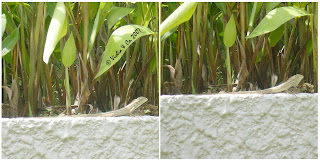Me and Cp finally pop by the lab to see our dear friendsss. While we were inside, Sj was telling us that 186, one of the catch from Wednesday night, had died. After doing a dissection on the fellow, he found 14 fishes in its gut! I just went 'WAAAHHH!'. Amazing right! So cool huh, 14 fishes in the gut, ranging from very big ones to teeny weeny ones. And 186 itself is not even that big, probably about 3+ cm in diameter only. How can? Why did it swallow so many fishes when the rest weren't even digested yet? I always thought that they eat one and that's it. They will only feed after the food has been digested, but apparently not. The reason why it died was due to excessive bleeding. Sj found this wood splinter in the snake and when he did the dissection, he realised that the gut was already torn apart by the splinter. Ouch, poor snakey.
[Life is a cycle, so lets move on.]
189. Why is it special to me. Because it is the BIGGEST wild dog-faced that I have ever catch (til now). As the chinese saying goes, '姜是老的辣'. I was waiting for it to swallow the fish but it showed no intention to. It just swam around the rocks and I thought it was looking for a more secure spot to feed and avoid being swept away by the current. Nah. It continued navigating around the rocks while I looked on and eventually, Cp and I chased after the snake again. It was only when I saw the helpless fish flapping under doggy's bite did I realised that it was still alive. Smart fish. Smarter doggy. Dumb homosapien.
After much waiting, 189 finally began to savour its dinner. This fellow is a darn seasoned feeder! It looked as though there was a conveyor belt within the snake's mouth to transport the fish to the gut. The now-dead fish seemed to "glide" straight into doggy's mouth, out of my sight. I was utterly amazed! (For a "mountain tortoise", this is one scene which I hardly ever witness.) My dear 189 had just swallowed a relatively big fish, effortlessly.
Here are some animals I saw on Wednesday night.


I think this is the tree climbing crab. It looks like one. Spot the crab and the unknown dead insect? I actually saw the crab shredding the insect and eating it. EeewwW! And homosapiens eat crabs, though not this species.
 I hate centipedes and it has never cross my mind that one can find centipedes at the canal! Yucks, just when I was beginning to feel at ease hunting around the canal and walking over barnacles infested rocks, I see centipedes! Apparently they can't swim. Haha! But they can jump on rocks! This BIG one was stranded on an isolated rock and I tried to capture it (with my camera of cos). I think it got startled by my camera's flash cos it began jumping on the rock! They are sensitive to light ah? All of us hate centipedes; Sj wanted to kill it and throw it into the water to feed the snakes, ha!
I hate centipedes and it has never cross my mind that one can find centipedes at the canal! Yucks, just when I was beginning to feel at ease hunting around the canal and walking over barnacles infested rocks, I see centipedes! Apparently they can't swim. Haha! But they can jump on rocks! This BIG one was stranded on an isolated rock and I tried to capture it (with my camera of cos). I think it got startled by my camera's flash cos it began jumping on the rock! They are sensitive to light ah? All of us hate centipedes; Sj wanted to kill it and throw it into the water to feed the snakes, ha!

Nerite snails. Quite a lot on the rocks. They love rocks eh? Can find them on rock bunds too.
 Crescent perch? Sj said its a perch. It was pretty, prettier than those you normally find in the canal. But pretty things do not last. We found that it died after the hunt ended.
Crescent perch? Sj said its a perch. It was pretty, prettier than those you normally find in the canal. But pretty things do not last. We found that it died after the hunt ended.

Dead bird found by Sp. Young heron?
 See the plaster on my leg? The work of the barnacles from my previous trip.
See the plaster on my leg? The work of the barnacles from my previous trip.

The site. Adios.













